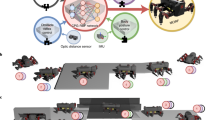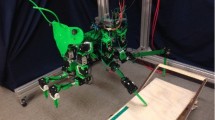Abstract
Controlling the model of an one-legged robot is investigated. The model consists merely of a mass less spring attached to a point mass. The motion of this system is characterised by repeated changes between ground contact and flight phases. It can be kept in motion by active control only. Robots that are suited for fast legged locomotion require different hardware layouts and control approaches in contrast to slow moving ones. The spring mass system is a simple model that describes this principle movement of a spring-legged robot. Multi-Layer-Perceptrons (MLPs), Radial Basis Functions (RBFs) and Self-Organising Motoric Maps (SOMMs) were used to implement neurocontrollers for such a movement system. They all prove to be suitable for control of the movement. This is also shown by an experiment where the environment of the spring-mass system is changed from even to uneven ground. The neurocontroller is performing well with this additional complexity without being trained for it.
Similar content being viewed by others
Explore related subjects
Discover the latest articles and news from researchers in related subjects, suggested using machine learning.Author information
Authors and Affiliations
Rights and permissions
About this article
Cite this article
Maier, K., Glauche, V., Beckstein, C. et al. Controlling fast spring-legged locomotion with artificial neural networks. Soft Computing 4, 157–164 (2000). https://doi.org/10.1007/s005000000041
Issue Date:
DOI: https://doi.org/10.1007/s005000000041




